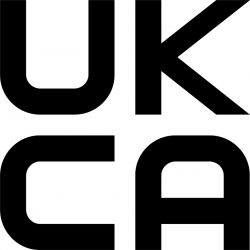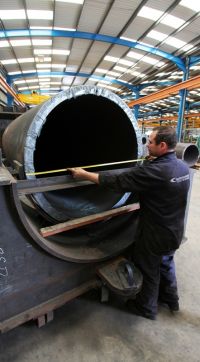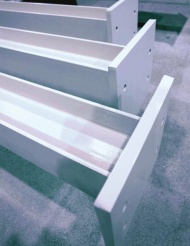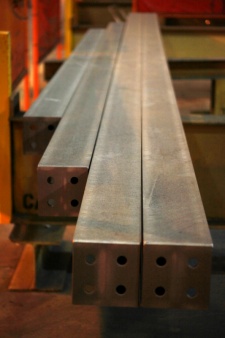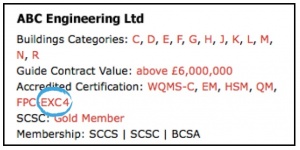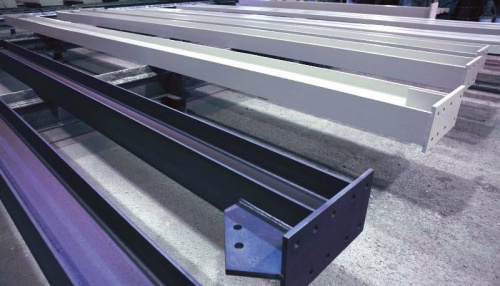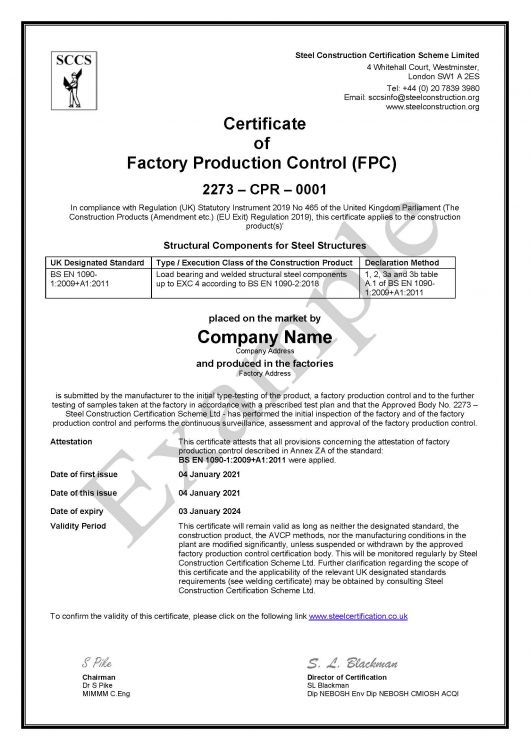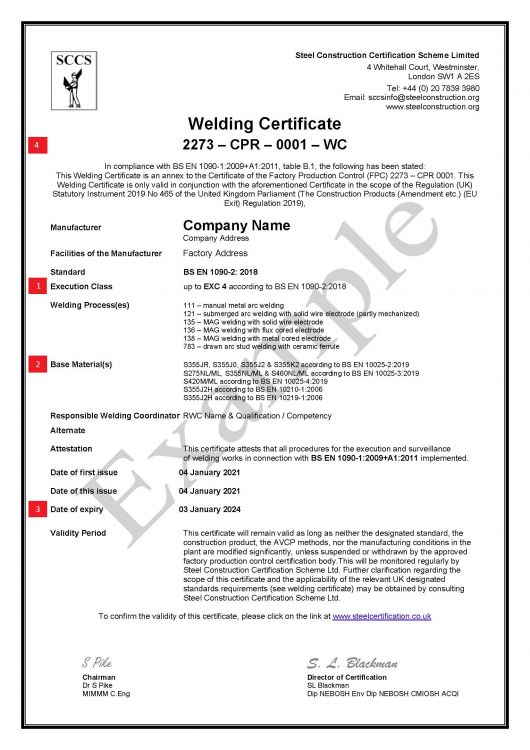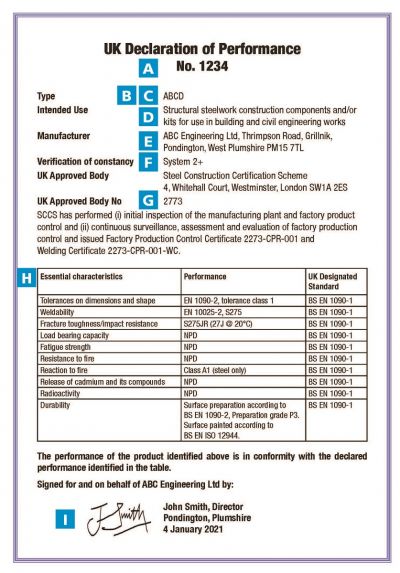Difference between revisions of "UKCA marking"
| Line 299: | Line 299: | ||
==Resources== | ==Resources== | ||
*[[Media:Steel_construction_-_UKCA_Marking_v6.pdf|Steel construction – UKCA Marking supplement, 2022]] | *[[Media:Steel_construction_-_UKCA_Marking_v6.pdf|Steel construction – UKCA Marking supplement, 2022]] | ||
| − | *[https://britishsteel.co.uk/media/ | + | *[https://britishsteel.co.uk/media/vv2la1v1/uk-sections-datasheets-100723.pdf British sections product range datasheets, British Steel] |
*[https://www.tatasteeleurope.com/sites/default/files/TATA_3598%20Celsius%20Overview%20Brochure%20Update%20DEC21%20%283%29.pdf Celsius® Hot finished hollow sections to EN 10210. 2022, Tata Steel] | *[https://www.tatasteeleurope.com/sites/default/files/TATA_3598%20Celsius%20Overview%20Brochure%20Update%20DEC21%20%283%29.pdf Celsius® Hot finished hollow sections to EN 10210. 2022, Tata Steel] | ||
*[https://www.tatasteeleurope.com/sites/default/files/Hybox%C2%AE%20355%20technical%20guide.pdf Hybox® 355 technical guide, Structural hollow sections. 2010, Tata Steel] | *[https://www.tatasteeleurope.com/sites/default/files/Hybox%C2%AE%20355%20technical%20guide.pdf Hybox® 355 technical guide, Structural hollow sections. 2010, Tata Steel] | ||
Latest revision as of 08:01, 2 October 2023
CE marking for all construction products, covered by a harmonised European standard or conforming to a European Technical Assessment became mandatory in the European Union (EU) on 1 July 2013. For fabricated structural steelwork, CE marking became mandatory in the EU on 1 July 2014. This represented a major development for engineers, contractors and steelwork specialists and demanded careful attention to the new obligations imposed by the EU Construction Products Regulation[1], which was the legal basis for the new regime.
CE marking is now familiar to most construction professionals and continues for products placed on the EU market, which includes the Republic of Ireland. However, now that the United Kingdom (UK) of Great Britain (GB) and Northern Ireland (NI) has left the EU a new system of UK Conformity Assessed marking (UKCA marking) has been introduced.
This article describes UKCA marking, spells out in detail what it means for the rest of the construction sector and what you need to do to comply with the Construction Products Regulations[2], which is the legal basis for the new regime in the UK.
[top]Introduction
UK Conformity Assessed marking (UKCA marking) demonstrates compliance with the appropriate manufacturing standard for a product placed on the UK market of Great Britain (GB), comprising England, Scotland and Wales. For the UK market of Northern Ireland (NI) the equivalent is CE and UKNI. Introduced on 1 January 2021 it covers goods that previously required CE marking for products sold in the European Union (EU), of which the UK was formerly a member.
Under the Construction Products Regulation (CPR)[2], legal obligations are placed on manufacturers, distributors and importers of construction products used within the UK market of GB to UKCA mark their products where they are covered by a UK designated standard. This applies not only to constituent products (such as steel beams and bolts etc.) but also to fabricated elements and systems made from both UKCA marked and non-UKCA marked products. Similar obligations apply in NI where such products should be CE and UKNI marked.
CE marking will continue to be recognised in both the UK markets of GB and NI until 30 June 2025, but from 1 July 2025 CE marking will no longer be acceptable in GB.
In the UK, Trading Standards is the enforcement agency for non-compliance. Penalties for non-compliance include suspension notices, prohibition notices, notices to warn and application for forfeiture. For certain offences the penalties may include a fine, imprisonment or both.
The CPR[2] describes the legal obligations it places on the construction supply chain in terms of ‘manufacturers’, ‘distributors’ and ‘importers’. However, the construction supply chain in the UK would normally be described in terms of clients, designers, specifiers, contractors and specialist subcontractors. The purpose of this article is to provide some guidance to the UK supply chain on the implications of the CPR[2] on steel construction.
The requirements of the CPR[2] and UKCA marking (and NI equivalent) apply to construction products used on a project irrespective of the design standard adopted for that project, i.e. BS 5950[3] or BS EN 1993[4] for example.
[top]UKCA marking of products
UKCA marking is the UK product marking that is now used for goods being placed on the market in GB. It covers goods which previously required CE marking. Goods can carry both the CE and UKCA markings so long as they are fully compliant with both UK and EU regulations.
The UKCA marking demonstrates compliance with the appropriate designated standard for a product. All mainstream construction products are covered by UK designated standards and must therefore be UKCA marked, although CE marking can still be used in GB until 30 June 2025.
A list of the relevant European harmonised standards and their equivalent UK designated standards is provided in the table (below). Initially, the European harmonised standards and the UK designated standards will be the same. However, in the future, there may be the need to supplement the UK designated standards in some way so they continue to meet the requirements of the UK.
| Product | European Harmonised Standards | UK Designated Standards | |
|---|---|---|---|
| Open sections | BS EN 10025-1[5] | BS EN 10025-1[5] | |
| Hollow sections | Hot finished | BS EN 10210-1[6] | BS EN 10210-1[6] |
| Cold formed welded | BS EN 10219-1[7] | BS EN 10219-1[7] | |
| Plates | BS EN 10025-1[5] | BS EN 10025-1[5] | |
| Structural bolts | Non-preloaded structural bolting assemblies | BS EN 15048-1[8] | BS EN 15048-1[8] |
| High strength structural bolting assemblies for preloading | BS EN 14399-1[9] | BS EN 14399-1[9] | |
| Fabricated structural steelwork | BS EN 1090-1[10] | BS EN 1090-1[10] | |
Note:
- A full list of European harmonised standards can be found on the EU’s Nando website.
- A full list of UK designated standards can be found on the Government website
For UKCA marking, manufacturers must publish UK declarations of performance (DoPs) for their products.
Special arrangements apply in Northern Ireland where goods placed on the market still need to meet EU rules, as demonstrated by mandatory third-party conformity assessments. If the assessment is carried out by an EU Notified Body, then the products will be CE marked. If it is carried out by a UK Approved Body/Notified Body (NI), then the products will carry both a CE mark and a UKNI mark. This applies equally to construction products and fabricated steelwork.
[top]UKCA marking of fabricated structural steelwork
For fabricated structural steelwork, engineers, contractors and steelwork contractors should have amended their specifications to require that only UKCA marked (or CE marked until 30 June 2025) products are used on their projects in GB.
The UK designated standard covering fabricated structural steelwork is BS EN 1090-1[10], which is the same as the current European harmonised standard. All fabricated structural steelwork delivered to a site in GB must be UKCA marked (or CE marked until 30 June 2025) against BS EN 1090-1[10].
BS EN 1090-1[10] gives Requirements for Conformity Assessment of Structural Components. It describes how manufacturers can demonstrate that the components they produce meet the declared performance characteristics (the structural characteristics which make them fit for their particular use and function).
BS EN 1090-2[11] gives Technical Requirements for Steel Structures. It specifies the requirements for the execution (fabrication and erection) of steel structures to ensure adequate levels of mechanical resistance and stability, serviceability and durability. It determines the performance characteristics for components that the manufacturer must achieve and declare through the requirements of BS EN 1090-1[10].
CE marking compliance became a condition of membership of the BCSA from 1 July 2014. BCSA now requires members to be compliant with the marking schemes in GB, NI and Ireland as appropriate (see table). This means that selection of any BCSA Member company will guarantee that the steelwork contractor will have the necessary certification to comply with BS EN 1090-1[10]. Clients and main contractors will therefore continue to have confidence in the complete supply chain for steel construction from manufacture of the steel sections through distribution to fabrication and erection on site.
[top]Specifications
Contracts for fabricated structural steelwork for buildings should include the National Structural Steelwork Specification (NSSS) for Building Construction (7th Edition), which incorporate the obligations of BS EN 1090-1[10] and BS EN 1090-2[11] on the steelwork contractor.
[top]Engineer’s responsibility
For any project, the required quality of fabrication or Execution Class (EXC) must be specified. The procedure to determine the Execution Class is set out in Annex C of BS EN 1993-1-1[12] and its associated UK National Annex[13]. The Execution Class should be specified for:
- The works as a whole
- An individual component
- A detail of a component
The engineer is responsible for specifying the Execution Class for the structure (the works as a whole), and for components and details where it is appropriate to specify an Execution Class different to that specified for the structure. Where different, the Execution Class for a component or detail should not be lower than that specified for the works as a whole. The Execution Class for a component or detail should be clearly identified in the execution specification if it is different to the Execution Class for the structure.
The procedure for determining the Execution Class for buildings is a straightforward two-step process:
Whilst each building needs to be considered on its own merits, Execution Class 2 (EXC2) will be appropriate for the majority of buildings constructed in the UK. If the Consequences Class is not specified, clause NA.2.27.2 of the National Annex to BS EN 1993-1-1[13] states that it should be assumed that the design rules in BS EN 1993[4] are safe for classes up to and including Consequences Class 2.
It should also be noted that the body of the NSSS for Building Construction has been written for the steelwork contractor to deliver the requirements of EXC2. The 7th edition includes specific requirements for EXC3 in annexes for static and fatigue design of structures.
[top]Determine the Consequences Class
The purpose of categorising the Consequences Class (CC) is to ensure that buildings are constructed with the appropriate level of quality control within the fabrication process. The Consequences Class for a building is derived on the basis of building type, building height (number of storeys), floor plan area per storey (for retail) and occupancy. A structure, or a part of it, could also contain components with different Consequences Classes.
Table 11 of Approved Document A[14] may be used to determine the Consequences Class for a range of building types and occupancy. In Table 11, CC2a and CC2b are subdivisions of CC2 when determining the Execution Class required for a structure.
| Consequences Class | Building type and occupancy |
|---|---|
| 1 | Houses not exceeding 4 storeys. Agricultural buildings. |
| 2a Lower Risk Group |
5 storey single occupancy houses. Hotels not exceeding 4 storeys. |
| 2b Upper Risk Group |
Hotels, blocks of flats, apartments and other residential buildings greater than 4 storeys but not exceeding 15 storeys. Educational buildings greater than 1 storey but not exceeding 15 storeys. |
| 3 | All buildings defined above as Consequences Class 2a and 2b that exceed the limits on area and/or number of storeys. Grandstands accommodating more than 5,000 spectators. |
Notes:
- For buildings intended for more than one type of use the Consequences Class should be that pertaining to the most onerous type.
- In determining the number of storeys, basement storeys may be excluded provided such basement storeys fulfil the robustness requirements of Consequences Class 2b buildings.
- BS EN 1991-1-7[15] with its UK National Annex[16] also provides guidance that is comparable to Table 11.
As note 1 of Table 11 states, the Consequences Class for a mixed-use building will be that pertaining to the most onerous occupancy type.
Table 11 presents the Consequences Classes for the buildings it considers in a helpful but generic way. Where a building falls just outside the threshold of CC2 in Table 11, designers may wish to determine the Consequences Class from first principles to see if CC2 can still be applied. Section 5.4 of Approved Document A[14] sets out this alternative approach.
[top]Selection of Execution Class
Having determined the Consequences Class for a building, the required Execution Class is simply derived from Table NA.4 of the National Annex to BS EN 1993-1-1[13] (see below).
| Parts of BS EN 1993[4] which are applicable to the design of the structure1 |
All relevant Parts except Part 1-9[17] or Part 1-12[18] |
All relevant Parts including Part 1-9[17] and/or Part 1-12[18] | ||
|---|---|---|---|---|
| Other Eurocodes applicable to the design of the structure1 (in addition to BS EN 1990 [19] and BS EN 1991[20]) | Required | - | - | BS EN 1998[21] |
| Optional | BS EN 1994[22] | BS EN 1994[22] | BS EN 1994[22] | |
| Execution Classes | RC1, CC1 RC2, CC2 |
Minimum EXC2 | Generally EXC3 | Generally EXC3 |
| RC3, CC3 | EXC3 | Minimum EXC3 | Minimum EXC3 | |
Note:
- or a distinct, clearly identifiable zone of a structure.
For the majority of buildings constructed in the UK, EXC2 will be the appropriate requirement. Where the Consequences Class is not specified, clause NA.2.27.2 of the National Annex to BS EN 1993-1-1[13] states that it should be assumed that the design rules in BS EN 1993[4] are safe for classes up to and including Consequences Class 2.
The engineer should always derive the Execution Class based on the design parameters appropriate to each project. The requirements to each Execution Class are listed in Table A3 of BS EN 1090-2[11] and can be reviewed by the engineer if desired.
However, the engineer should avoid overspecification of the Execution Class wherever possible to avoid unnecessary costs being introduced. For example, EXC2 is the Execution Class derived for a project but the engineer requires full traceability (an EXC3 requirement) instead of the partial/batch traceability requirement of EXC2. Rather than specifying EXC3 on the basis of achieving this single clause requirement, it is suggested that EXC2 is still specified but with the higher level of traceability added to the specification.
[top]Steelwork contractor requirements for UKCA Marking
If steelwork contractors are already CE marked and their Notified Body has become a UK Approved Body, they do not have to be recertified until their next scheduled audit.
In order to be able to UKCA mark the fabricated structural steelwork that they produce, steelwork contractors are required to declare performance to the System 2+ System of Assessment and Verification of Constancy of Performance (as described in Annex V of the CPR[2]). This requires them to undertake:
- Initial type-testing of the product
- Factory Production Control (FPC), which includes
- Implementation of FPC system procedures
- Appointment of a responsible welding coordinator (RWC)
- Implementation of welding quality management system (WQMS) procedures
- Further testing of samples taken at the factory in accordance with the prescribed test plan
They must also be assessed by a UK Approved Body that will carry out:
- Initial inspection of the manufacturing plant
- Initial inspection of the FPC
- Continuous surveillance, assessment and approval of the FPC, which will typically include:
- An annual audit to ensure continued competence to the declared Execution Class (Table B.3 of BS EN 1090-1[10] sets out minimum levels for the routine surveillance intervals)
The UK Approved Body will then issue a FPC certificate and Welding Certificate identifying the Execution Class that the steelwork contractor has achieved.
[top]Client and/or main contractor’s responsibility
For all fabricated structural steelwork delivered to site in GB there is a legal requirement under the CPR[2] that it is UKCA marked (or CE marked until 30 June 2025).
In order to achieve this, the client or main contractor should appoint a steelwork contractor with an Execution Class equal to that required for the project. It should be noted that steelwork contractors with EXC3 capability can be used for EXC1, 2, & 3; and a steelwork contractor with EXC2 capability can only be used for EXC1 & 2.
The BCSA has made compliance with the marking schemes in GB, NI and Ireland (as appropriate) a condition of membership of the Association, so selection of a BCSA Member company ensures that the steelwork contractor has the necessary accreditation to comply with the CPR[2] requirements.
The directories for buildings and bridgeworks on BCSA’s website include details of accredited certification levels achieved by each member. Clients and main contractors can use this to find steelwork contractors with an Execution Class equal to that required for their project.
Contract documentation should also be updated to incorporate the NSSS (7th Edition), which incorporates the obligations of BS EN 1090-1[10] and BS EN 1090-2[11] on the steelwork contractor.
It should be noted that if an EU steelwork contractor is used on a project, the CPR[2] puts liability on clients and/or main contractors. In that instance, the party engaging the steelwork contractor would be classed as an importer under the CPR[2] and must comply with ‘Obligations of Importers’ given in Article 13 of the regulations.
Special arrangements apply in Northern Ireland where goods placed on the market still need to meet EU rules, as demonstrated by mandatory third-party conformity assessments. If the assessment is carried out by an EU Notified Body, then the products will be CE marked. If it is carried out by a UK Approved Body/Notified Body (NI), then the products will carry both a CE mark and a UKNI mark. This applies equally to construction products and fabricated steelwork.
[top]How to check compliance with the CPR and UKCA Marking
In order for a steelwork contractor to demonstrate their right to UKCA mark their products, they must provide the following three documents:
- Factory Production Control (FPC) certificate – issued by a UK Approved Body
- Welding certificate as required by BS EN 1090-1[10]
- UK Declaration of Performance (UK DoP) – issued by the steelwork contractor
The client or main contractor engaging the steelwork contractor should carry out due diligence before appointing them. Likewise, insurers should complete a similar due diligence process before giving Professional Indemnity insurance to a steelwork contractor who must UKCA mark their products.
Selecting a BCSA Member will ensure compliance with the relevant legislation. The client, main contractor or insurer would not need to carry out due diligence of the steelwork contractor in this case since it has already been undertaken by the BCSA as part of their membership audit.
[top]What to check – Factory Production Control and Welding Certificates
- Declared performance – ensure that the steelwork contractor meets or exceeds the Execution Class requirements for the project.
- Base materials – the steelwork contractor is covered for welding with material strength and subgrades up to and including those declared on the Welding Certificate. Ensure that these are consistent with the requirements of the project.
- Date of expiry – check that the certificate is still current and covers the period of the contract.
- Certification Body:
- Notified body number – check on the EU’s Nando website to ensure that it is a valid and current number associated with the notified body named on each certificate.
- UK Approved Body number – check the Government database to ensure that it is a valid and current number associated with the UK Approved Body named on each certificate. The UK Approved Body numbers will be the same for those Notified Bodies transferred to UK Approved Bodies at the end of 2020.
There will be a transition period, before the steelwork contractor’s next audit, where they may continue to hold a Factory Production Control (FPC) Certificate and a Welding Certificate issued by their certification body before 1 January 2021 (i.e. when they were an EU Notified Body). However, their previous Declaration of Performance will need to be updated to a UK Declaration of Performance against BS EN 1090-1[10] immediately. The UK Approved Body will issue a new Factory Production Control (FPC) Certificate and a new Welding Certificate at the next recertification audit.
[top]What to check – UK Declaration of Performance
The UK Declaration of Performance (UK DoP) is very similar to the Declaration of Performance (DoP) and must be made available with products that are UKCA marked. The content of the UK DoP should include:
- Reference number for the UK DoP.
- Unique identification code of the product type.
- Type, batch or serial number or any other element allowing identification of the construction product.
- Intended use or uses in accordance with the UK designated standard (e.g. BS EN 1090-1[10]) .
- Name, registered trade name or registered trademark and contact address of the manufacturer.
- System or systems of assessment and verification of constancy of performance (e.g. 2+).
- Name and identification number of the UK Approved Body.
- A table listing the essential characteristics given in the UK designated standard together with the declared performance and the reference number for the UK designated standard.
- A declaration signed for on behalf of the manufacturer.
[top]Arrangements for Northern Ireland
[top]Conformity assessment
The Northern Ireland Protocol came into force on 1 January 2021 and for as long as it applies, manufactured goods placed on the market in Northern Ireland will need to meet EU rules. EU conformity markings will continue to be used to show such goods meet the EU rules, and for construction products this will continue to be CE marking, i.e. all construction products placed on the market in NI must comply with the EU CPR, as demonstrated by a mandatory third-party conformity assessment.
If that conformity assessment is carried out by an EU Notified Body, then the products would carry a CE mark and can be placed on the EU as well as the NI market.
If the conformity assessment is carried out by a UK Approved Body/Notified Body (NI), then the products would carry both a CE mark and a UKNI mark. The CE and UKNI marks resulting from the conformity assessment by the UK Approved Body/Notified Body (NI) allow the products to be placed on the NI market. The UKNI mark cannot be used in isolation, it must be carried alongside the CE mark.
Note that the UKNI mark is not recognised by the EU, so if goods are to be placed on the EU market, they must use the CE mark only, without the UKNI mark, and the conformity assessment must be carried out by an EU Notified Body.
For products manufactured in GB and also traded in the GB market, any CE or CE and UKNI marking that may be required for NI will be in addition to UKCA marking (the UKCA marking alone cannot be used for goods placed on the market in NI; it needs to be accompanied by either the CE mark from an EU Notified Body or the CE and UKNI marks from a UK Approved Body/Notified Body (NI)).
[top]Moving goods from Northern Ireland to Great Britain
The UK government has guaranteed unfettered access for Northern Ireland’s businesses to the whole of the UK market, without the need for additional approvals before placing goods on the market in the rest of the UK. Qualifying Northern Ireland goods, including construction products, may be placed on the market in Great Britain based on the conformity markings used in Northern Ireland.
| Market | Until 30 June 2025 | From 1 July 2025 |
|---|---|---|
| Great Britain (GB) | UKCA or CE and UKNI or CE | UKCA or CE and UKNI or CE+ |
| Northern Ireland (NI) | CE and UKNI or CE | CE and UKNI or CE |
| Republic of Ireland | CE | CE |
Note:
- CE+ - CE marking from an EU Notified Body is only recognised in GB from 1 July 2025 for qualifying Northern Ireland goods under unfettered access.
[top]References
- ↑ Construction Products Regulation (EU) No. 305/2011 of the European Parliament and of the Council of 9 March 2011, Official Journal of the European Union L88/5 4.4.2011
- ↑ 2.0 2.1 2.2 2.3 2.4 2.5 2.6 2.7 2.8 2.9 For the purposes of this article CPR refers to The Construction Products (Amendment etc.) (EU Exit) Regulations 2019 (S.I. 2019/465) and provisions in the European Union (Withdrawal Agreement) Act 2020 (Commencement No. 1) Regulations 2020 (S.I. 2020/75)
- ↑ BS 5950 Structural use of steelwork in building (Various Parts). BSI
- ↑ 4.0 4.1 4.2 4.3 BS EN 1993 Eurocode 3. Design of steel structures (Various Parts). BSI
- ↑ 5.0 5.1 5.2 5.3 BS EN 10025-1: 2004, Hot rolled products of structural steels, Part 1: General technical delivery conditions, BSI
- ↑ 6.0 6.1 BS EN 10210-1: 2006, Hot finished structural hollow sections of non-alloy and fine grain structural steels. Part 1: Technical delivery requirements. BSI
- ↑ 7.0 7.1 BS EN 10219-1: 2006, Cold formed welded structural sections of non-alloy and fine grain steels. Part 1: Technical delivery requirements. BSI
- ↑ 8.0 8.1 BS EN 15048-1:2016, Non-preloaded structural bolting assemblies. General requirements, BSI
- ↑ 9.0 9.1 BS EN 14399-1:2015, High-strength structural bolting assemblies for preloading. General requirements, BSI
- ↑ 10.00 10.01 10.02 10.03 10.04 10.05 10.06 10.07 10.08 10.09 10.10 10.11 10.12 BS EN 1090-1:2009+A1:2011 Execution of steel structures and aluminium structures. Requirements for conformity assessment of structural components. BSI
- ↑ 11.0 11.1 11.2 11.3 BS EN 1090-2:2018 Execution of steel structures and aluminium structures Technical requirements for steel structures. BSI
- ↑ BS EN 1993-1-1:2005+A1:2014, Eurocode 3: Design of steel structures. General rules and rules for buildings, BSI
- ↑ 13.0 13.1 13.2 13.3 NA+A1:2014 to BS EN 1993-1-1:2005+A1:2014, UK National Annex to Eurocode 3: Design of steel structures General rules and rules for buildings, BSI
- ↑ 14.0 14.1 Approved Document A (Structure) 2004 Edition incorporating 2004, 2010, and 2013 amendments. Ministry of Housing, Communities & Local Government
- ↑ BS EN 1991-1-7:2006+A1:2014. Eurocode 1: Actions on structures. General actions. Accidental actions. BSI
- ↑ NA+A1:2014 to BS EN 1991-1-7:2006+A1:2014. UK National Annex to Eurocode 1: Actions on structures. General actions. Accidental actions. BSI
- ↑ 17.0 17.1 BS EN 1993-1-9:2005, Eurocode 3. Design of steel structures. Fatigue, BSI
- ↑ 18.0 18.1 BS EN 1993-1-12: 2007, Eurocode 3. Design of steel structures. Additional rules for the extension of EN 1993 up to steel grades S 700, BSI
- ↑ BS EN 1990:2002+A1:2005. Eurocode: Basis of structural design. BSI
- ↑ BS EN 1991 Eurocode 1. Actions on structures. (Various Parts). BSI
- ↑ BS EN 1998 Eurocode 8. Design of structures for earthquake resistance. (Various Parts). BSI
- ↑ 22.0 22.1 22.2 BS EN 1994 Eurocode 4: Design of composite steel and concrete structures. (Various Parts). BSI
[top]Resources
- Steel construction – UKCA Marking supplement, 2022
- British sections product range datasheets, British Steel
- Celsius® Hot finished hollow sections to EN 10210. 2022, Tata Steel
- Hybox® 355 technical guide, Structural hollow sections. 2010, Tata Steel
- UK Declarations of Performance certificates for British Steel products
- UK Declarations of performance for Tata Steel (structural hollow section) products
- National Structural Steelwork Specification (7th Edition), 2020, (Publication No. 62/20), BCSA
- Corrigenda - First Revision National Structural Steelwork Specification (7th edition), 2023, (Publication No. 67/23), BCSA
- Commentary (3rd edition) on the National Structural Steelwork Specification for Building Construction (7th edition), 2022, (Publication No. 66/22), BCSA
- SCI P391 Structural Robustness of Steel Framed Buildings, 2011
[top]See also
- Steel construction products
- Fabrication
- Steelwork specification
- Specification of bridge steelwork
- Steel manufacture
- Structural robustness
- Construction
- Welding





